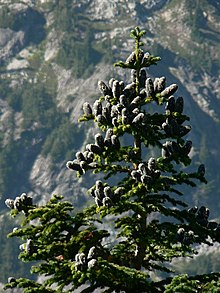Subalpine Fir
| Subalpine fir | |
|---|---|
 |
|
| Subalpine fir, North Cascades National Park | |
| Scientific classification | |
| Kingdom: | Plantae |
| Division: | Pinophyta |
| Class: | Pinopsida |
| Order: | Pinales |
| Family: | Pinaceae |
| Genus: | Abies |
| Species: | A. lasiocarpa |
| Binomial name | |
|
Abies lasiocarpa (Hooker) Nuttall |
|
 |
|
| Natural range of Abies lasiocarpa | |
Abies lasiocarpa, commonly called the subalpine fir or Rocky Mountain fir, is a western North American fir tree.
Abies lasiocarpa is native to the mountains of Yukon, British Columbia and western Alberta in Western Canada; and to southeastern Alaska, Washington, Oregon, Idaho, western Montana, Wyoming, Utah, Colorado, New Mexico, Arizona, northeastern Nevada, and the Trinity Alps of the Klamath Mountains in northwestern California in the Western United States.
It occurs at high altitudes, from 300–900 metres (980–2,950 ft) in the north of the range (rarely down to sea level in the far north), to 2,400–3,650 metres (7,870–11,980 ft) in the south of the range; it is commonly found at and immediately below the tree line.
It is a medium-sized tree growing to 20 metres (66 ft) tall, exceptionally to 40–50 metres (130–160 ft) tall, with a trunk up to 1 metre (3.3 ft) across, and a very narrow conic crown. The bark on young trees is smooth, gray, and with resin blisters, becoming rough and fissured or scaly on old trees. The leaves are flat and needle-like, 1.5–3 cm (5⁄8–1 1⁄8 in) long, glaucous green above with a broad stripe of stomata, and two blue-white stomatal bands below; the fresh leaf scars are reddish. They are arranged spirally on the shoot, but with the leaf bases twisted to be arranged to the sides of and above the shoot, with few or none below the shoot. The cones are erect, 6–12 cm (2 1⁄4–4 3⁄4 in) long, dark blackish-purple with fine yellow-brown pubescence, ripening brown and disintegrating to release the winged seeds in early fall.
...
Wikipedia

